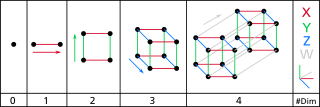Hypercube
convex polytope, the n-dimensional analogue of a square and a cube From Wikipedia, the free encyclopedia
In geometry, a hypercube is a kind of polytope. It is an analogue of a square (n = 2) or a cube (n = 3) in another number of dimensions (which is known as n-dimensional). A hypercube is a closed, compact, convex figure that is made of groups of opposite parallel line segments aligned in each of the space's dimensions, perpendicular to each other and of the same length.
An n-dimensional hypercube is also called an n-cube or an n-dimensional cube. The term "measure polytope" is also used, notably in the work of H. S. M. Coxeter (originally from Elte, 1912),[1] but it has been superseded.
The hypercube is the special case of a hyperrectangle (also called an n-orthotope), where all of its parts are equal.
A unit hypercube is a hypercube whose side has length one unit. Often, the hypercube whose corners (or vertices) are the 2n points in Rn with each coordinate equal to 0 or 1 is called "the" unit hypercube. A unit hypercube's longest diagonal in n dimension is equal to .
Construction


A hypercube can be made by making a copy of the last hypercube and moving it into the next dimension, then connecting the two objects. They are as follows:
- 0 – A point is a hypercube of dimension zero.
- 1 – If one moves a copy of the point by one unit length, it will sweep out a line segment, which is a unit hypercube of dimension one.
- 2 – If one moves a copy of this line segment in a perpendicular direction from itself; it sweeps out a 2-dimensional square.
- 3 – If one moves a copy of the square by one unit length in the direction perpendicular to the plane it lies on, it will make a 3-dimensional cube.
- 4 – If one moves a copy of the cube by one unit length into the fourth dimension, it makes a 4-dimensional unit hypercube (a unit tesseract).
This can be done in any number of dimensions. This process of sweeping out the polytopes can be formalized mathematically as a Minkowski sum: the d-dimensional hypercube is the Minkowski sum of d mutually perpendicular unit-length line segments, and is therefore an example of a zonotope.
The 1-skeleton of a hypercube is a hypercube graph.
Related pages
- Simplex - the n-dimensional analogue of the triangle
- Hyperrectangle - the general case of the hypercube, where the base is a rectangle.
Notes
Other websites
Wikiwand - on
Seamless Wikipedia browsing. On steroids.



